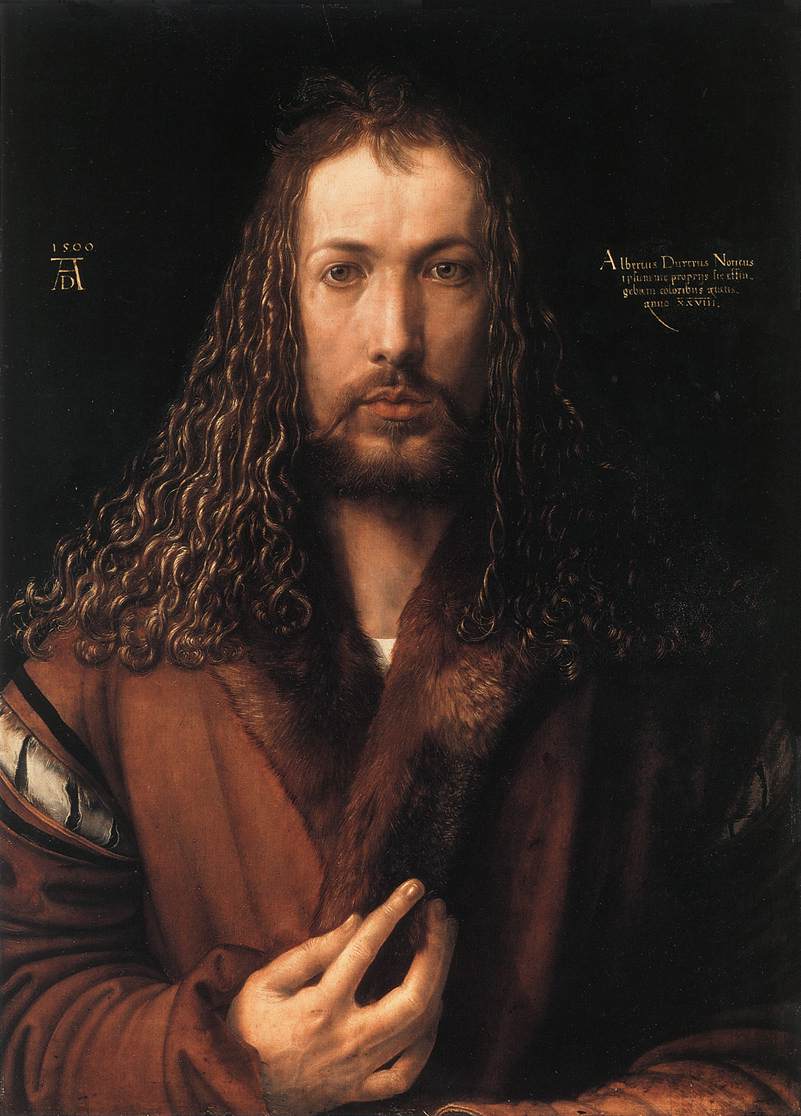|
Portrait Diptych Of Dürer's Parents
''Portrait Diptych of Dürer's Parents'' (or ''Dürer's Parents with Rosaries'') is the collective name for two late-15th century portrait panels by the German painter and printmaker Albrecht Dürer. They show the artist's parents, Barbara Holper () and Albrecht Dürer the Elder (), when she was around 39 and he was 63 years. The portraits are unflinching records of the physical and emotional effects of ageing. The Dürer family was close, and Dürer may have intended the panels either to display his skill to his parentsThausing (2003), 45 or as keepsakes while he travelled soon after as a journeyman painter. They were created either as pendants, that is conceived as a pair and intended to hang alongside each other, or diptych wings. However, this formation may have been a later conception; Barbara's portrait seems to have been executed some time after her husband's and it is unusual for a husband to be placed to the viewer's right in paired panels. His father's panel is co ... [...More Info...] [...Related Items...] OR: [Wikipedia] [Google] [Baidu] |
Germanisches Nationalmuseum
The Germanisches National Museum is a museum in Nuremberg, Germany. Founded in 1852, it houses a large collection of items relating to German culture and art extending from prehistoric times through to the present day. The Germanisches National Museum is Germany's largest museum of cultural history. Out of its total holding of some 1.3 million objects (including the holdings of the library and the Department of Prints and Drawings), approximately 25,000 are exhibited. The museum is situated in the south of the historic city center between Kornmarkt and Frauentormauer along the medieval city wall. Its entrance hall is situated on Kartäusergasse which was transformed by the Israeli sculptor Dani Karavan to the Way of Human Rights (german: Straße der Menschenrechte). Name, establishment, guiding principles The Germanisches Museum, as it was named initially, was founded by a group of individuals led by the Franconian baron Hans von und zu Aufsess, whose goal was to assemble ... [...More Info...] [...Related Items...] OR: [Wikipedia] [Google] [Baidu] |
Erwin Panofsky
Erwin Panofsky (March 30, 1892 in Hannover – March 14, 1968 in Princeton, New Jersey) was a German-Jewish art historian, whose academic career was pursued mostly in the U.S. after the rise of the Nazi regime. Panofsky's work represents a high point in the modern academic study of iconography, which he used in hugely influentialShone, Richard and Stonard, John-Paul, eds. ''The Books that Shaped Art History'', chapter 7. London: Thames & Hudson, 2013. works like his "little book" ''Renaissance and Renascences in Western Art'' and his masterpiece, '' Early Netherlandish Painting''. Many of his works are still in print, including ''Studies in Iconology: Humanist Themes in the Art of the Renaissance'' (1939), ''Meaning in the Visual Arts'' (1955), and his 1943 study ''The Life and Art of Albrecht Dürer''. Panofsky's ideas were also highly influential in intellectual history in general,Chartier, Roger. ''Cultural History'', pp. 23–24 (from "Intellectual History and the Histor ... [...More Info...] [...Related Items...] OR: [Wikipedia] [Google] [Baidu] |
Bonnet (headgear)
Bonnet has been used as the name for a wide variety of headgear for both sexes—more often female—from the Middle Ages to the present. As with "hat" and "cap", it is impossible to generalize as to the styles for which the word has been used, but there is for both sexes a tendency to use the word for pop styles in soft material and lacking a brim, or at least one all the way round, rather than just at the front. Yet the term has also been used, for example, for steel helmets. This was from Scotland (in 1505), where the term has long been especially popular.''OED'', "Bonnet" Headgear tied under the chin with a string was especially likely to be called a bonnet. Other features associated with bonnets as opposed to hats was that the forehead was not covered, and the back of the head often was. The outdoor headgear of female servants and workers was more likely to be called a bonnet. It was often worn outside over a thinner everyday head covering, which was worn at all times. In ... [...More Info...] [...Related Items...] OR: [Wikipedia] [Google] [Baidu] |
Portrait Of Barbara Dürer Detail
A portrait is a painting, photograph, sculpture, or other artistic representation of a person, in which the face and its expressions are predominant. The intent is to display the likeness, personality, and even the mood of the person. For this reason, in photography a portrait is generally not a snapshot, but a composed image of a person in a still position. A portrait often shows a person looking directly at the painter or photographer, in order to most successfully engage the subject with the viewer. History Prehistorical portraiture Plastered human skulls were reconstructed human skulls that were made in the ancient Levant between 9000 and 6000 BC in the Pre-Pottery Neolithic B period. They represent some of the oldest forms of art in the Middle East and demonstrate that the prehistoric population took great care in burying their ancestors below their homes. The skulls denote some of the earliest sculptural examples of portraiture in the history of art. Historical portraitur ... [...More Info...] [...Related Items...] OR: [Wikipedia] [Google] [Baidu] |
Arranged Marriage
Arranged marriage is a type of marital union where the bride and groom are primarily selected by individuals other than the couple themselves, particularly by family members such as the parents. In some cultures a professional matchmaker may be used to find a spouse for a young person. Arranged marriages have historically been prominent in many cultures. The practice remains common in many regions, notably South Asia, the Middle East, North Africa, and the Caucasus. In many other parts of the world, the practice has declined substantially during the 19th and 20th centuries. Forced marriages, practiced in some families, are condemned by the United Nations. The specific sub-category of forced child marriage is especially condemned. In other cultures, people mostly choose their own partner. History Arranged marriages were very common throughout the world until the 18th century. Typically, marriages were arranged by parents, grandparents or other close relatives and trusted friends. ... [...More Info...] [...Related Items...] OR: [Wikipedia] [Google] [Baidu] |
Lotte Brand Philip
Lotte Brand Philip (May 27, 1910 – May 2, 1986) was a German art historian, professor and expert on Netherlandish art, one of the most notable and incisive experts on 14th- and 15th-century art to have studied under Erwin Panofsky. Born a Christian of Jewish descent, she resisted state intimidation to leave Germany, only moving to the United States in 1941. She began her new life as a jewelry designer, before establishing a career as an art historian and writer, and taking professorship at a number of universities, including New York University and Queens College, Flushing. During her long career, Brand wrote highly regarded books and monographs on artists such as Jan van Eyck, Albrecht Dürer and Hieronymus Bosch, and in 1980 became emeritus at Queens. Brand Philip died on May 2, 1986 in New York City. Early life Lotte Johanna Friederike Brand was born in Altona, Hamburg, Germany, on May 27, 1910, to Friedrich Wilhelm Brand and Anna Majud.''Contemporary Authors Online'' She st ... [...More Info...] [...Related Items...] OR: [Wikipedia] [Google] [Baidu] |
Imprimatura
In painting, imprimatura is an initial stain of color painted on a ground. It provides a painter with a transparent, toned ground, which will allow light falling onto the painting to reflect through the paint layers. The term itself stems from the Italian and literally means "first paint layer". Its use as an underpainting layer can be dated back to the guilds and workshops during the Middle Ages; however, it came into standard use by painters during the Renaissance, particularly in Italy. The imprimatura not only provides an overall tonal optical unity in a painting but is also useful in the initial stages of the work, since it helps the painter establish value relations from dark to light. It is most useful in the classical approach of indirect painting, where the drawing and underpainting are established ahead of time and allowed to dry. The successive layers of color are then applied in transparent glaze or semi-transparent layers. Care is taken not to cover the imprimatura c ... [...More Info...] [...Related Items...] OR: [Wikipedia] [Google] [Baidu] |
Lacquer
Lacquer is a type of hard and usually shiny coating or finish applied to materials such as wood or metal. It is most often made from resin extracted from trees and waxes and has been in use since antiquity. Asian lacquerware, which may be called "true lacquer", are objects coated with the treated, dyed and dried sap of ''Toxicodendron vernicifluum'' or related trees, applied in several coats to a base that is usually wood. This dries to a very hard and smooth surface layer which is durable, waterproof, and attractive in feel and look. Asian lacquer is sometimes painted with pictures, inlaid with shell and other materials, or carved, as well as dusted with gold and given other further decorative treatments. In modern techniques, lacquer means a range of clear or pigmented coatings that dry by solvent evaporation to produce a hard, durable finish. The finish can be of any sheen level from ultra matte to high gloss, and it can be further polished as required. Lacquer finishes ... [...More Info...] [...Related Items...] OR: [Wikipedia] [Google] [Baidu] |
Michael Wolgemut
Michael Wolgemut (formerly spelt ''Wohlgemuth''; 143430 November 1519) was a German painter and printmaker, who ran a workshop in Nuremberg. He is best known as having taught the young Albrecht Dürer. The importance of Wolgemut as an artist rests not only on his own individual works, but also on the fact that he was the head of a large workshop, in which many different branches of the fine arts were carried on by a great number of pupil-assistants, including Albrecht Dürer, who completed an apprenticeship with him between 1486 and 1489. In his ''atelier'' large altar-pieces and other sacred paintings were executed, and also elaborate carved painted wood retables, consisting of crowded subjects in high relief, richly decorated with gold and colour. Wolgemut was a leader among the artists reviving the standards of German woodcut at this time. The production of woodcuts was a large part of the work of the workshop, the blocks being cut from Wolgemut's designs. They were mostly made ... [...More Info...] [...Related Items...] OR: [Wikipedia] [Google] [Baidu] |
Self-Portrait (Dürer, Munich)
''Self-Portrait'' (or ''Self-Portrait at Twenty-Eight'') is a panel painting by the German Renaissance artist Albrecht Dürer. Painted early in 1500, just before his 29th birthday, it is the last of his three painted self-portraits. Art historians consider it the most personal, iconic and complex of his self-portraits.Bailey, 68 The self-portrait is most remarkable because of its resemblance to many earlier representations of Christ. Art historians note the similarities with the conventions of religious painting, including its symmetry, dark tones and the manner in which the artist directly confronts the viewer and raises his hands to the middle of his chest as if in the act of blessing. Description Dürer's face has the inflexibility and impersonal dignity of a mask, hiding the restless turmoil of anguish and passion within. In its directness and apparent confrontation with the viewer, the self-portrait is unlike any that came before. It is half-length, frontal and highly symme ... [...More Info...] [...Related Items...] OR: [Wikipedia] [Google] [Baidu] |









